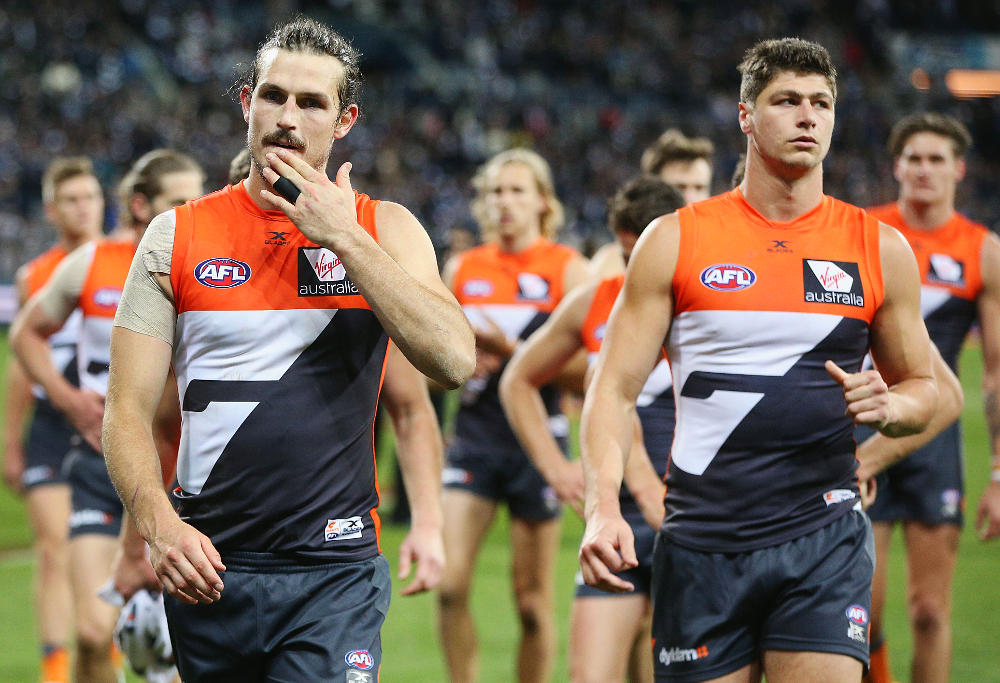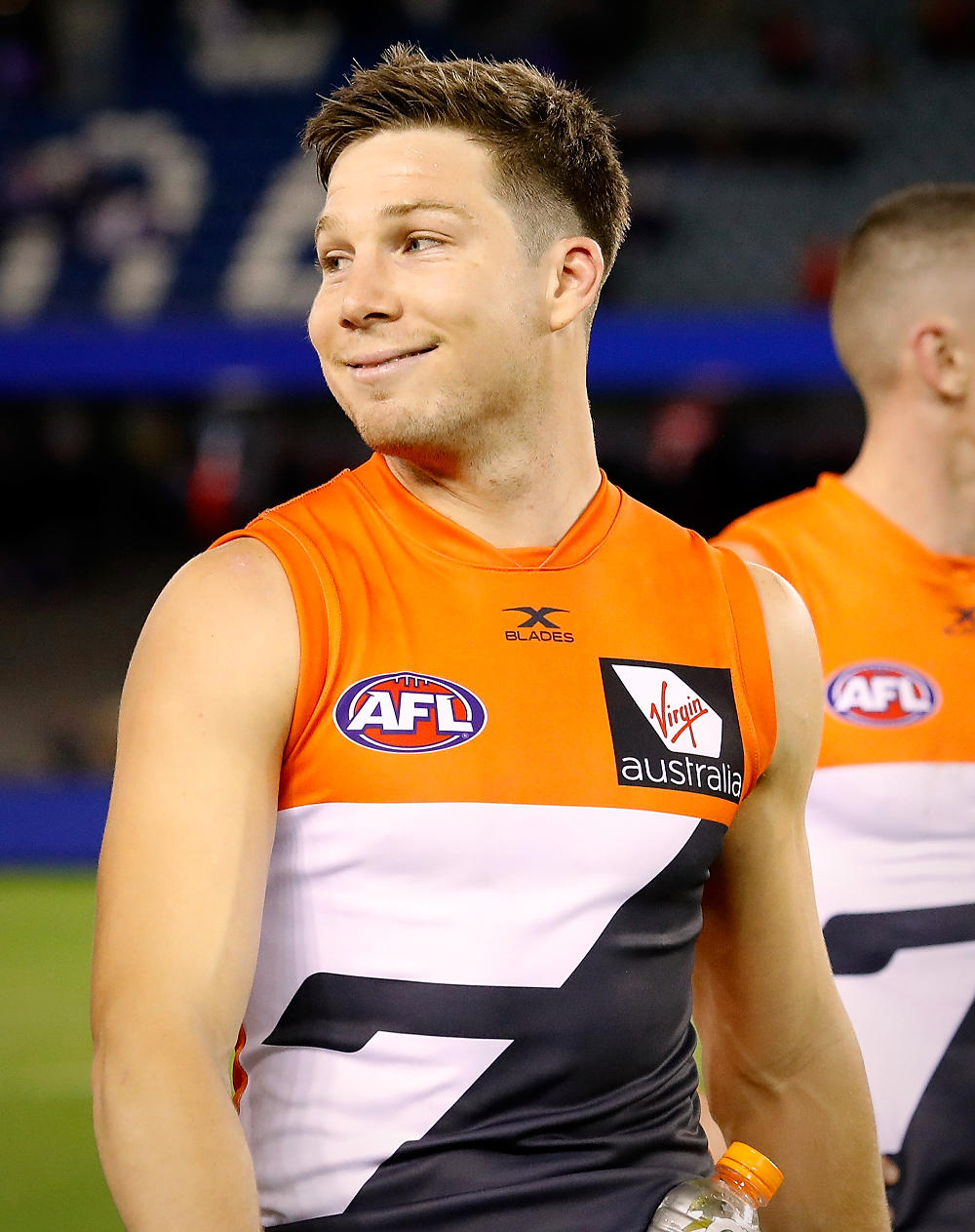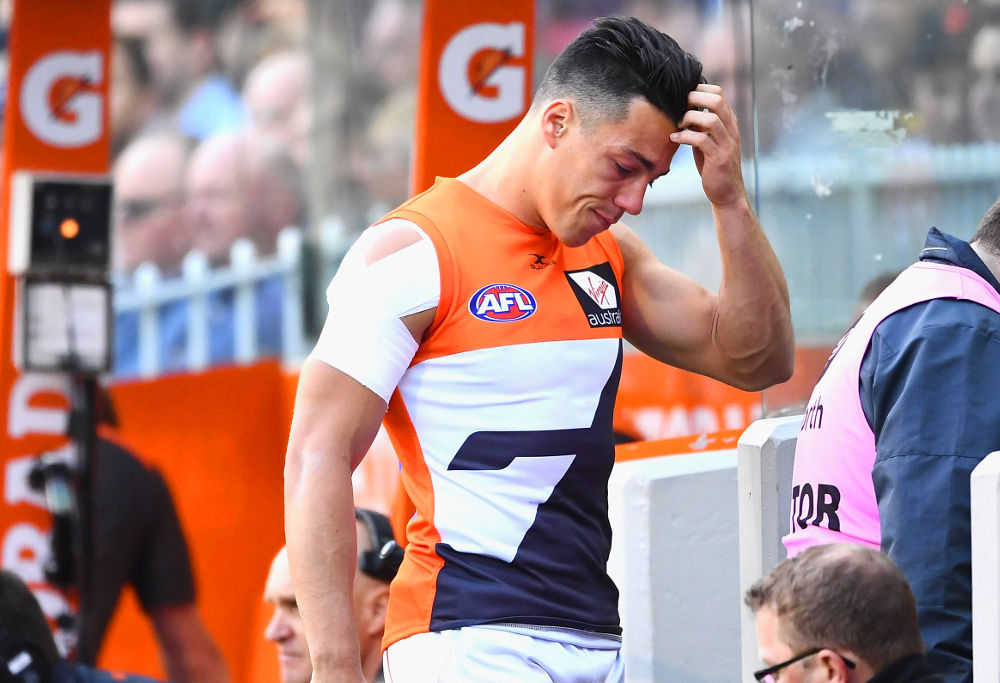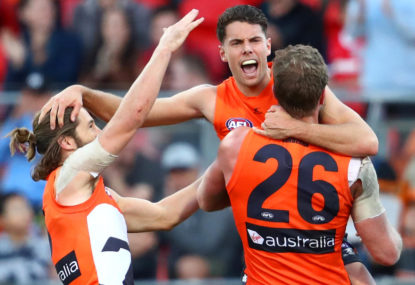Three years of nips and tucks have eaten away at the Greater Western Sydney Giants’ playing list, to the point where there are concerns about depth. What people are really saying – even if they don’t know it – is GWS are now just like the rest of the competition.
GWS had a near-three-year window where they could straddle two worlds which are usually mutually exclusive: a young list, and a completely stacked list.
In 2015 (11-11), they looked set for a shock finals appearance, until Shane Mumford went down with a season-ending ankle injury. In 2016 (16-6), they emerged as the multi-year premiership contender we knew was lurking, only to fall to eventual premier the Western Bulldogs in one of the best preliminary finals in AFL times.
In 2017 (14-2-6), the Giants were hit by injury all year, but managed to break into the top four; they lost a preliminary final to eventual premiers Richmond.
Ahead of each of those seasons, they added mature-age players to supplement the original core. Joel Patfull (2014), Ryan Griffen (2014), Steve Johnson (2015), Dawson Simpson (2015), Brett Deledio (2016), Matt de Boer (2016) and Tendai Mzungu (2016) all joined in that run; Heath Shaw and Mumford came a year prior.

Shane Mumford (AAP Image/Tracey Nearmy)
These players all made their mark; many are no longer on the list. As these players have joined, the Giants have lost a number of their own draftees.
For instance, almost the entire 2014 draft class has left for other clubs – the sole survivor is Jeremy Finlayson, an academy player taken with a pick in the 90s. Be it money, opportunity, homesickness, or ‘homesickness’ in aide of the former, the GWS have faced an unprecedented situation.
Each list has its own uniqueness. The Giants’ is (subjectively) far and away the most eclectic in the league. For it all, they find themselves with a league-high 19 players in the prime age 24 to 29-year-old bracket (on par with Port Adelaide and Geelong), and five more in the veteran class.
And, for the first time in those two brackets, Greater Western Sydney’s own drafted players (ten) outnumber the ring ins (nine).
The club has played a central role in the past two seasons, and if the market is any guide, they are set to make it three in a row. But this time, it’s different.
Target date: 2018
I suspect 2018 was the year the AFL Commission had circled on its calendar when working up the expansion-team entry concessions towards the end of the last decade. Their seventh year of professional football was set as the soft target for GWS to contend for a premiership.
It wouldn’t all come at once – there would be a finals campaign or two to help build the buzz – but come the latter part of the decade, it was time for the Giants’ reign to begin.
They would have been competing with the Gold Coast Suns, were it not for the Curse of the Coast. Now that the AFL has tried and all-but-failed to establish a professional team up there, joining soccer, rugby league, rugby union and basketball, we can officially call the Gold Coast a sporting graveyard. The Suns had generous entry concessions in line with the Giants, just a year prior. They enter 2018 as the team most likely to win the wooden spoon.
I bring this up not to rehash old arguments – about entry concessions, or the Gold Coast, or Gold Coast’s entry concessions – but as a device to heap as much praise on the various administrators who have been in charge of GWS’s list and recruiting teams over the journey.
Their early list management teams plucked talented players from all around the country, and spun them back out again as a means to accessing a clutch of high draft picks in 2011-12-13, who have now grown together into the team we see today.
This year was supposed to be the year of true contention because it is when the young GWS players taken in 2010 and 2011, both through the draft and with pre-list concessions, would hit football adulthood.
The club’s first pick in the 2011 draft, Jonathon Patton, turns 25 in Round 10. He, the rest of his class still on the list, and the handful of pre-listed players that still call Western Sydney their football home, have been together for seven years. A length of time not dissimilar to Geelong’s superdraft class of 2001, or Hawthorn’s premiership team in 2013.

Jonathon Patton (AAP Image/Julian Smith)
West Coast’s premiership contending list was built in the off seasons seven or so years prior to their 2015 grand final loss. Richmond took a year or two longer than that, but were contending seven years after they selected Jack Riewoldt (2006), Shane Edwards (2006), Trent Cotchin (2007) and Alex Rance (2007). The Dogs still have a few years to run until they reach the threshold, but you get the picture.
That the Giants earned their contender stripes a year or two early is a testament to just how well the club has executed its list management strategy. Anyone can draw a full house at a poker table, but that is no guarantee you’ll win the hand.
GWS’s core group of 24 to 25-year-olds were as close to that full house as you could ask for. Sitting a year or two above them on the birthday board are Tom Scully, Phil Davis and Callan Ward; they’re the bluff, raise and re-raise. The trio joined as uncontracted players ahead of the Giants’ first season, as 19, 20 and 21-year-olds with blue-chip credentials. They have lived up to their billing.
Other veteran additions have proven handy along the way. The list is long, and you know it already. Each has played an important role in helping build the club to where it is today, but also allowed them to accelerate the natural rise up the ladder that would come with the ballooning development of the initial draft crop.
Coming into the 2018 season, Greater Western Sydney sit sixth for total AFL experience, and ninth for average age. Last year, the club was in second place, their veteran additions in the three years prior holding the reins and helping push the group deep into September. No more.
This 2018 team is what the club was destined to become: a regular old premiership contender.
[latest_videos_strip category=”afl” name=”AFL”]
Depth? Depth! You’re not looking at the big picture
Which brings us to the depth argument. It is an easy argument to make looking at the list of departures in the past two years alone. The volume of list turnover has been such that Greater Western Sydney hasn’t actually delisted anyone.
The closest they’ve got was the 2016 delisting of Jake Barrett, who ended up being picked up by Brisbane as a delisted free agent. Everyone else that has left has done so via retirement or trade.
The list of trades is impressive. Paul Ahern, Will Hoskin-Elliott, Caleb Marchbank, Cam McCarthy, Pat McKenna, Rhys Palmer, Jarrod Pickett, Jack Steele, and James Stewart in the 2016 offseason; Matthew Kennedy, Devon Smith, and Nathan Wilson last off season.
GWS absorbed the 2016 losses without much fanfare. Losing Kennedy, Smith and Wilson this past summer will hit much closer to home. The trio played important roles, albeit towards the bottom of a stacked rotation (or a little higher in the case of Wilson).
Kennedy was the likely successor to Callan Ward as the lead inside attack dog – at 19 he played 16 games for a team with a loaded midfield that finished in the top four. Smith was part of an outside attacking midfield unit that quickly became the Giants’ hallmark. Wilson too, but in the back half, and with his main attacking weapon a raking right boot. All three would have been expected to be best-22 players in the coming campaign.
So, the Giants have lost depth. But they are coming from such a unique place that it’s low down the list of concerns. Now, rather than turning to another blue-chip midfielder who has been winning 30 touches or kicking five goals a game in the NEAFL, they turn to what every other club in the land turns to when things go awry.
The club has been quietly building its list of depth players as the more high-profile names have left the club through retirement and trades. They have two general forwards (de Boer and Carlton discard Dylan Buckley), a ruckman (Dawson Simpson), a key defender (Lachie Keefe), a running midfielder (Ryan Griffen, although he joined the club as a best-22 candidate) as well as two rookies the club has utilised in recent years (Sam Reid and Daniel Lloyd). They aren’t households names but they don’t need to be.
Meanwhile, the departures of recent years have allowed the club to reload on high draft picks. GWS made seven selections inside the top 20 in 2015, 2016 and 2017 drafts, including the established best-22 player, Jacob Hopper, and two guys who are already challenging for spots in Harrison Himmelberg and Tim Taranto. The reservoir runs deep.

Photo by Michael Dodge/Getty Images
Shifting roles
But depth only matters a heap when there’s a rash of injuries – like the Giants suffered last season. We can assume the club’s luck will regress to the mean in 2018. However, there are already some challenges.
Zac Williams – one of my favourite players in the league – is out for the season with an Achilles tendon injury. He is an enormous loss, but if there is any position the Giants have an ability to cover it is mid-sized, fleet-footed player with a great kicking boot. The club internally rates tall defender Nick Haynes’ kicking and decision making extremely highly, while Heath Shaw can do nothing if not kick the ball a long way. Adam Kennedy, one of the original prelisted players, has the ground game covered. Griffen has the running side of things covered too, while Brett Deledio – calves willing – is perfect for that role.
It may necessitate more of a shuffle in defensive 50 than coach Leon Cameron and his crew would have liked, but at least it happened in the preseason, and there are options galore.
They will also feel the loss of Will Setterfield, if only because he projects as another stellar all-around midfielder. The only way he was going to break into the side early doors was if he was destroying planets, and so the club is missing upside rather than realising downside.
Toby Greene’s broken toe has held up his preseason, but once more the club has options in his spot if he isn’t ready by his projected Round 1 return. He is far and away the number one attacking midfielder at the club, but the Giants managed without him for stretches last year.

Toby Greene (Photo by Adam Trafford/AFL Media/Getty Images)
The other big positional change the club must manage is in the centre square. Mumford had been the Giants’ ruckman for near enough to five years, doubling as one of the only mature bodies on the park early on. He’s gone, and Rory Lobb becomes the man most likely. This has significant implications across the ground.
GWS’s strategy of stockpiling highly rated tall-forward prospects has resulted in the retention of what loom as the two best: Patton and Jeremy Cameron. The duo will play full and half forward respectively, the former using his heft and latter his lateral pace. But more importantly, there will be less of a role for Lobb inside forward 50; clogging space and providing little forward pressure.
Instead, Lobb will be able to use his best attributes – his overhead marking, and athleticism-to-size ratio – to become one of the most useful general play ruckmen in the competition. He becomes an instant intercept-marking threat down the line or inside the defensive stripe. And the Giants will have the capacity to play an extra small or midsized player than they have in recent years.
Change is on the menu at the pointy ends. But you know what helps? An eight-man core midfield rotation that looks like this.
Callan Ward
Josh Kelly
Stephen Coniglio
Dylan Shiel
Tom Scully
Lachie Whitfield
Jacob Hopper
Tim Taranto

Dylan Shiel (Photo by Quinn Rooney/Getty Images)
This time, it’s different
The past two seasons have seen the Giants rise a little ahead of schedule. In 2018, their contender status is as was intended.
There is nary a weakness in their game. The most significant is perhaps forward pressure, and getting value for their dominance further up the ground. GWS had an adjusted contested possession differential of +8.9 per game last year, and had almost three more minutes of possession than their opponents on average – first and second in the league, respectively.
They were also extremely difficult to stop on the ground; an opposition tackle rate of 61.9 per 50 minutes was the lowest in the league. Sharpening up their attack, and capitalising on their midfield prowess, represents a clear opportunity for improvement.
The Giants should get a boost from injury luck regression. Lachie Whitfield won’t be missing for the first half of the season, nor Stephen Coniglio for the first two thirds. Switching out some grizzled veterans for homegrown youngsters will provide a fillip, even if there’s an adjustment period.
GWS will always have something of a challenging fixture; doubling up on Sydney, and playing opposition clubs at their homes-away-from-home are structural imbalances that will not go away anytime soon. However, they have one of the best home-ground advantages in the competition, and have turned Canberra into their own secondary fortress. Pythagorean wins suggest the Giants have a slightly easier fixture this year than last year.
This time it’s different; 2018 is the year the Giants become the team AFL House had scribbled on a whiteboard. The draft picks are coming into their own, and are now the central protagonists.
Greater Western Sydney will contend once again, and with a bit of luck will fulfil their destiny.


































































































